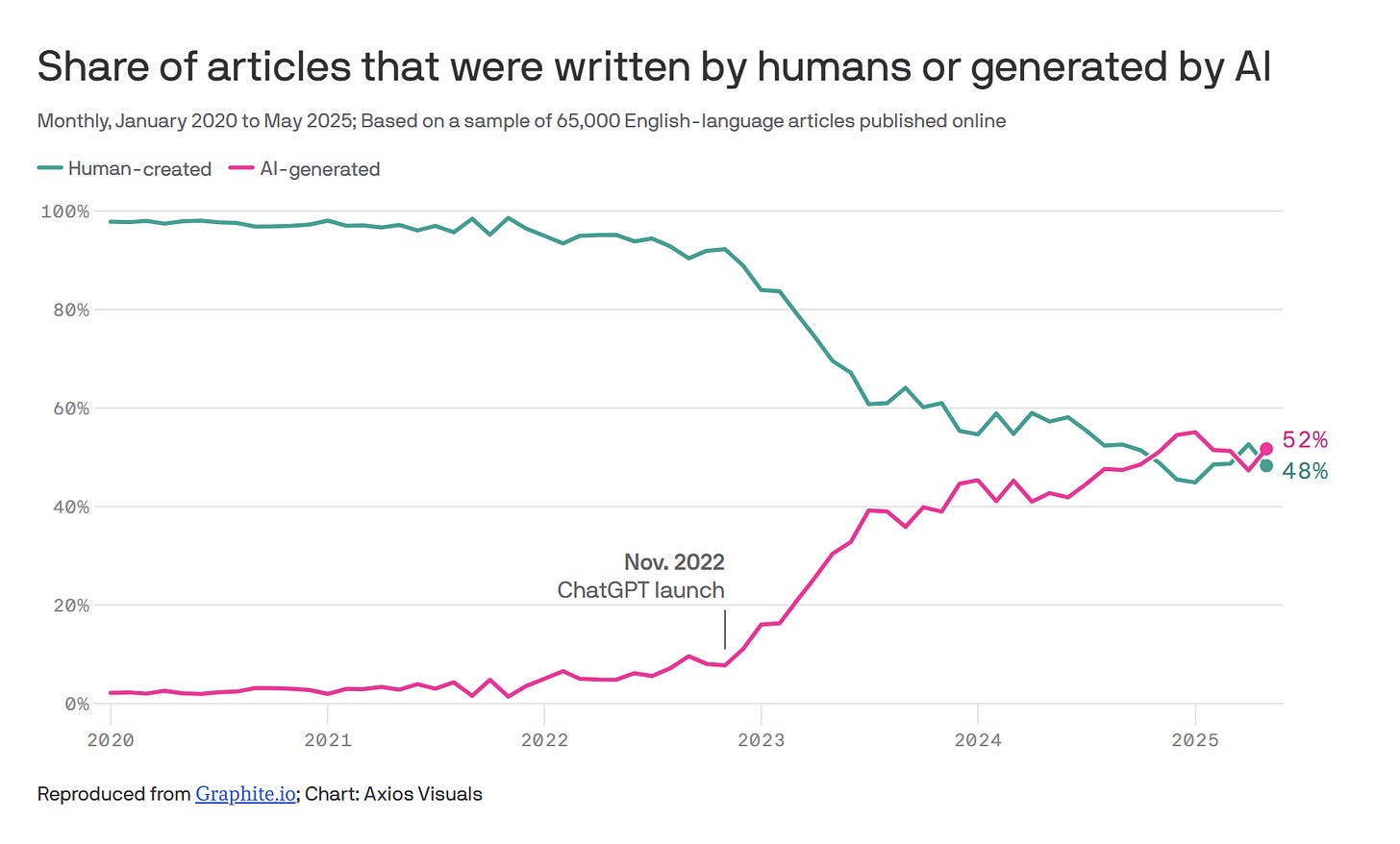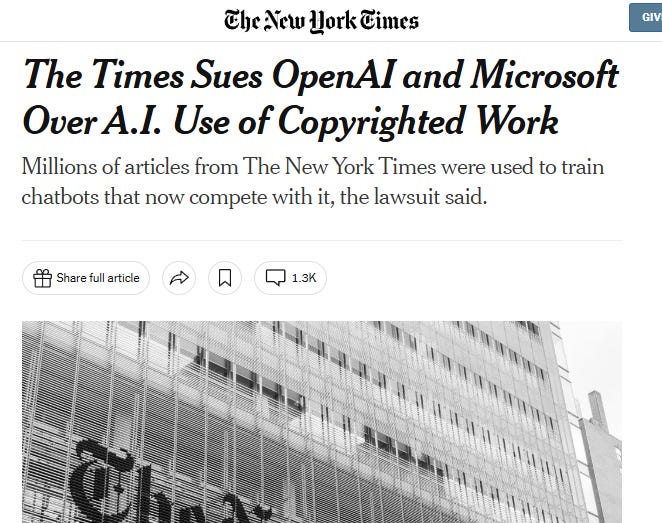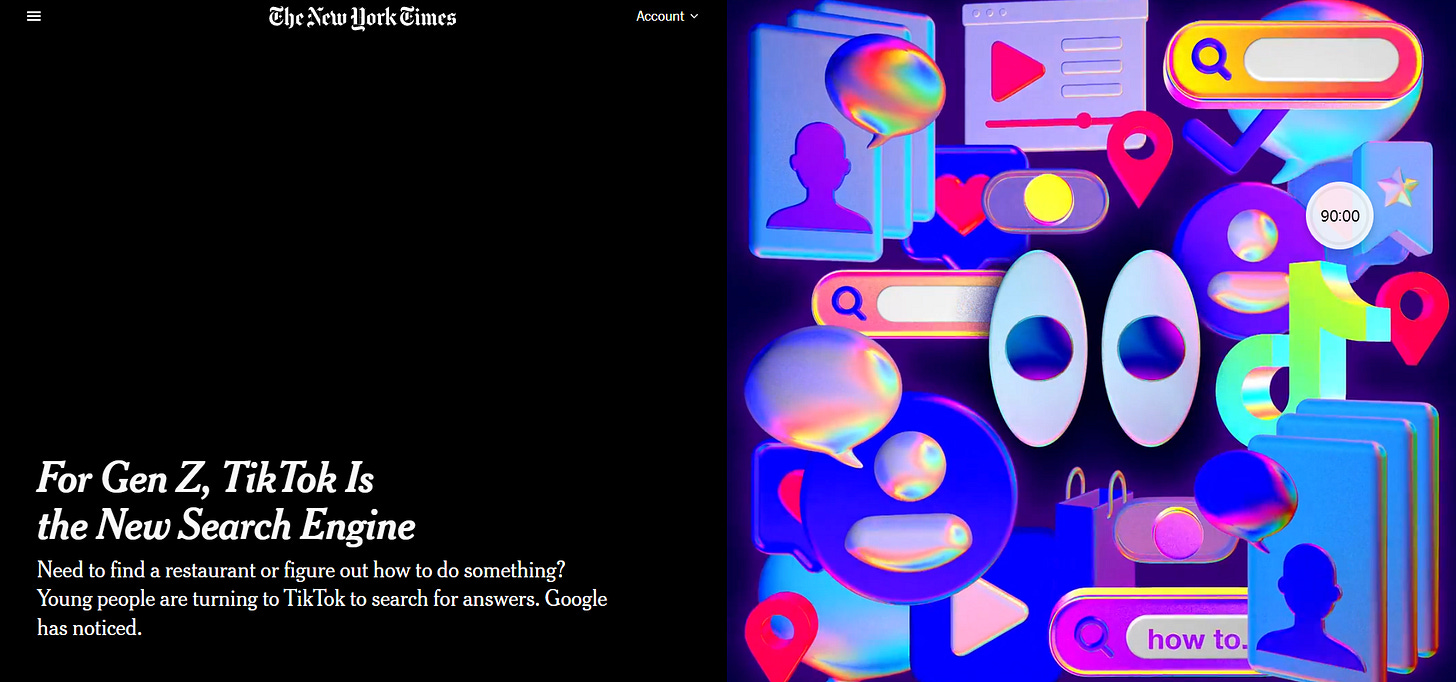Half of What You Read is AI: Visual
AI is reshaping how we create, share, and trust information. Three shifts will define what comes next.
The chart above suggests that AI-generated articles now make up about half of all online articles.
And while the chart focuses on articles, this shift likely extends into the workplace, where AI is used to create research reports, internal memos and strategy documents, sometimes with minor revisions.
Here are three business trends that will be increasingly important as a result.
1. Personal Brand Matters More Than Ever
With AI, anyone can create a piece of content or provide an opinion on nearly any topic.
As with quotes, the power of content lies not just in what is said, but in who is saying it.
If I said, “People don’t know what they want until you show it to them,” it wouldn’t mean much.
But when Steve Jobs said it and demonstrated it through Apple’s products, it became one of his most iconic ideas.
The irony is that to build credibility, you must still prove that you can think, write, and strategise independently of AI.
Otherwise, if ChatGPT can replicate all your thinking, why should people listen to you?
As a result, deep expertise will become more valuable.
2. The Business Model of the Internet Will Change.
The current business model of the internet works like this:
Peter creates helpful content and publishes it online for free.
James asks a question on Google, which finds Peter’s article that provides the answer.
James is happy; his question is answered. Peter is happy; he earns traffic and possibly revenue through ads, which incentivises him to keep creating.
But today, James increasingly asks the same question to ChatGPT, which reads and summarises Peter’s work in the background, without sending any traffic to Peter’s site.
Peter earns nothing for his effort, and over time, he has less incentive to produce new content.
If Peter and others like him stop creating, what will AI be trained on in future to answer James’s questions?
This problem has not been solved.
Some licensing deals have been agreed to reward this content creation.
For example, the New York Times has an agreement with Amazon to use its content for AI; however, the Times is also suing OpenAI for allegedly using its material without permission.
These cases show how complex and hard-to-value this new data economy is.
If AI models have been trained on content from The Herald, The Independent, or SABC, how much should that be worth?
Have companies in Africa started to explore what this would look like?
Data in Africa is much harder to gather and maintain. There surely should be a premium on it of some kind?
How this plays out could have a big impact on the business model of the internet.
Couldfare CEO and Founder has an idea of what that will look like.
“The Internet’s next business model will be powered by pay-per-use, fractional payments, and microtransactions—tools that shift incentives toward original, creative content that actually adds value,” -Matthew Prince, co-founder and CEO of Cloudflare.
Honestly, I am not entirely sure I see this, but I don’t think that’s what matters.
The most important thing is knowing that in less than 2-3 years, the way the information is consumed and created on the internet will be fundamentally different from what it is today, and we all need to get ready.
3. Visual Communication is Now a Must
As AI produces more written content, video and visual communication will become one of the few ways individuals can truly differentiate themselves.
It’s much harder for AI to replace how you communicate visually, your tone, expression, and delivery, than to replicate what you say in text.
Even if AI can generate realistic videos, the human element still carries more weight.
This means that the ability to communicate ideas through speech will become increasingly important.
This is a significant cultural shift, particularly when considering that the core of civilisation and much of society is tied to written texts, such as the Constitution, the Bible, the Quran, or other foundational texts.
While the above texts will remain relevant, new ideas communicated via text may hold less weight unless significant credibility has already been established. Much of that will have to come from visual communication.
This shift is already visible among younger generations.
As The New York Times has reported, many in Gen Z now treat TikTok, the video-focused app, as their preferred search engine rather than Google, turning to short visual explanations instead of written ones.
How much content do you think you read that is AI-generated, and what do you think will be the business model of the internet in future?
In case you are wondering😊, this article was written by a human with AI used to fact-check and edit phrasing.






Vibe coding is one of the most exciting tools introduced by AI. Non coders with domain knowledge/expertise can produce working prototype of software applications and pass on to software developers for further development.
What's happening to Gen Z (I'm Gen Z, right at cut off) is the great dumbing down. I've felt it in myself often. Short content does not give one the depth required to prompt deep, questioning thinking. This is my real concern with AI and social media.
My mind seems way less creative now, than it did in high school 2010s when I read 1000-page books for fun and spent hours in the garden meditating on these readings.
Even visual content, we used to watch 3-hour documentaries, now it's just 15 second shorts of some dude in selfie mode talking 'wisdom' or spitting facts while doing dishes. You won't get much depth from him.